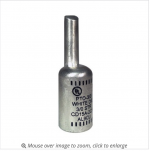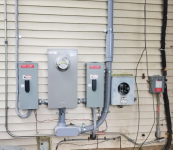SgtBOMBULOUS
Member
- Location
- Eldersburg MD
- Occupation
- Process Engineer
Hello! This will be my first post here. We recently had my house upgraded to a 400 amp service. Outside, from the overhead line, the electrician ran 350 kcmil down conduit and readied it to enter the new meter box. When the BGE contractor came, they set up the box, etc. Everything seemed great (They even replaced the service drop wire!).
But then... I overheard the "boss" telling his employee "Yah gotta really dig in when you're stripping these". He removed the outer ring of wires from the 350 in order to fit the end into a 4/0 lug. He called the 350 "overkill", and said he didn't have a lug for the 350.
He also left the CL200 meter unit in place. Also curious about opinions on this.
So... How concerned about this should I be? When the electric inspector came, he didn't think it was the right way to do it, but said there's nothing he can do about it, and that utilities basically do whatever they want.
Thanks!
But then... I overheard the "boss" telling his employee "Yah gotta really dig in when you're stripping these". He removed the outer ring of wires from the 350 in order to fit the end into a 4/0 lug. He called the 350 "overkill", and said he didn't have a lug for the 350.
He also left the CL200 meter unit in place. Also curious about opinions on this.
So... How concerned about this should I be? When the electric inspector came, he didn't think it was the right way to do it, but said there's nothing he can do about it, and that utilities basically do whatever they want.
Thanks!



